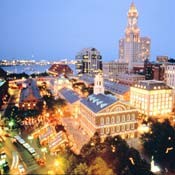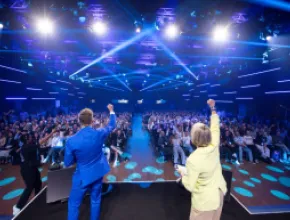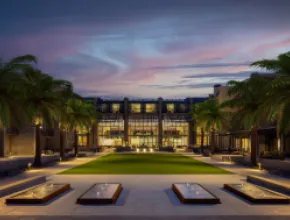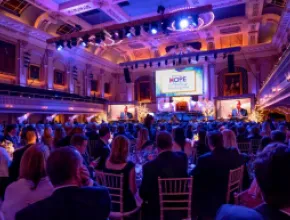Boston has been a base for innovation and revolution for a long time, from America’s struggle for independence to more recent innovations like the development of the World Wide Web. But this New England gateway doesn’t mow down her heritage sites in the quest for new ideas. She preserves them and gives them new purpose.
Among the city’s priorities following the completion of urban renewal projects that cost billions are sustainable practices, buildings and operations, many of which are implemented inside meeting facilities. If you want a green meeting, Boston is one of the easiest places in the country to organize it, especially in the area’s hotels, which by early 2009 will have an estimated inventory of nearly 21,500 within 15 minutes of Boston’s major convention facilities.
“This is a very exciting time to plan an event in Boston,” says Beth Stehley, vice president of convention services and sales for the Greater Boston CVB. “Planners find all the new development and revitalization we have affords them new opportunities to give their Boston events both a unique historic and cultural flavor, as well as first-class service and eco-responsible policies. Our bureau is getting the word out about our ‘green’ convention centers, hotels and restaurants—and even the hybrid taxicabs at Logan International Airport.”
Green and heritage coexist in Boston’s many fascinating historic neighborhoods, each with a unique story to tell. Within each district are great options for group tours, events and meeting sites that keep the history going, with sustainability in mind.
Neighborhood Nuances
Also known as Little Italy, the colorful North End is Boston’s oldest district of continuous habitation, having been settled in the 1630s. It’s been a center for Irish, Jewish and Italian immigrants. This is the place to enjoy small Italian restaurants and summer festivals and feasts that take place almost every summer weekend. Feasts honor patron saints from various regions of Italy.
Michelle Toper has been a resident for several decades, and her North End Market public and private group walking tours of the back streets and shops in the neighborhood showcase its culinary heritage.
North End also has some very old “burying grounds” that contain the remains of luminaries such as Cotton Mather, famous for his involvement with the Salem Witch Trials, as well as patriots John Hancock, Paul Revere and Samuel Adams. Ghost tours are available.
The nearby Financial District is home to one of the city’s most historic properties, The Langham, Boston, housed in the old Federal Reserve Bank.
Almost every Boston visitor wants to walk around Beacon Hill, a unique downtown neighborhood of Federal-style rowhouses, gaslit streets and brick sidewalks. Known as one of the most expensive residential districts in the U.S., it has quaint pubs, antique shopping and a location next to Boston Common and Boston Public Garden.
The Black Heritage Trail meanders through the district as it explores local 19th century African-American history. Meanwhile, African Meeting House, a church built on Beacon Hill in 1806, is nearing completion of a $4.5 million restoration. It’s been the site of many legendary events, including the speech by Frederick Douglass to recruit troops for the Civil War as depicted in the movie Glory. Private events can be held at the venue.
One of Beacon Hill’s newest meetings-ready properties is the 300-room Liberty Hotel, a conversion of the historic Charles Street Jail. Some of the property’s original features, including catwalks and jail cells, were preserved in the restoration and conversion project.
South End has a long history of cultural diversity and is today one of the city’s prime restaurant districts. Tremont Street is often called Restaurant Row, with cuisines ranging from American Southern Lowcountry to French, Ethiopian, Brazilian, Indian, Asian, Cuban, and Greek. Tiny bakeries and independent boutiques are also part of the South End scene.
South End was also a jazz mecca in the ’40s and ’50s, and Wally’s Cafe remains the place from that era to enjoy live jazz 365 days a year.
Wide tree-lined avenues and contemporary architectural styles define Back Bay. This is reclamation land that was created when the city filled in tidewater flats of the Charles River. The development began in 1857 and was completed in 1882, and was one of the land projects that doubled the size of the original Boston peninsula.
Back Bay is now one of the city’s toniest residential districts and home to the Hynes Convention Center and over 5,000 guest rooms in meetings-ready hotels such as The Boston Park Plaza, Boston Marriott Copley Place, Fairmont Copley Plaza, Hilton Boston Back Bay, Sheraton Boston, and Westin Copley Place. Mandarin Oriental Boston is one of the newest lodging faces in the district. Trendy shopping is popular along Newbury Street, Boston’s Rodeo Drive. Copley Square and Shops at the Prudential are in Back Bay, as are trendy outdoor cafes and restaurants, many with private dining spaces.
Catherine Chaulet, senior vice president of events with Best of Boston, a local DMC, says Prudential Tower’s Top of the Hub restaurant is one of her favorite event sites.
“It’s the place to get some of the most spectacular views of the Boston cityscape,” she says. “There are private dining spaces for 10 to 500 guests.”
Back Bay’s list of unique event venues also includes Boston Public Library, the oldest public library in America. Groups residing in this district’s hotels can walk to events at the library.
Fenway-Kenmore Square is not only home to the Boston Red Sox and historic Fenway Park, but also to more than a dozen of Boston’s 70 colleges and universities.
“Many groups like Boston’s sports side,” Chaulet says, “and we develop events around game times, as well as off-season dinners and other functions in the park. It’s a beautiful historic location.”
For a different cultural experience, the Isabella Stewart Gardner Museum; the Boston Museum of Fine Arts, which is undergoing a $450 million expansion; and Symphony Hall offer spaces for events in memorable historic surroundings.
“The beautiful art sets the mood for dinners in these museums,” Chaulet says. “We take cues from the paintings for table decor and invite opera singers and dancers to perform. If there’s a painting of a Spanish dancer on the wall, we ask our dancer to replicate the pose.”
Seaport District, south of downtown on the waterfront, is the site of two major group sites, Boston Convention & Exhibition Center (BCEC) and Seaport Hotel and Seaport World Trade Center. Other top meetings option in the district include two new properties: Westin Boston Waterfront, attached to the BCEC, and Renaissance Boston Waterfront Hotel.
Meanwhile, the history of the local fishing industry surrounds The Exchange Conference Center, one of the present-day operations that is housed in the circa-1915 rehabilitated mixed-use Fish Exchange Building. The center’s corporate and private function guests experience the heritage along with panoramic views of Boston Harbor.
Sometimes called Boston’s Left Bank, nearby Cambridge is the location of Harvard University and Massachusetts Institute of Technology (MIT). Cambridge’s five public squares, Central, Kendall, Harvard, Inman, and Lechmere, all function as neighborhood centers, and their diversity is popular with visitors who enjoy the artful, bohemian side of the Charles River in restaurants, clubs and shops.
Innovation Odyssey’s two-hour tours touch on the history and innovations that have emerged from Cambridge’s hallowed halls.
Cambridge Office of Tourism offers a new video and audio walking tour online, available as a virtual tour or downloadable to MP3 players, Windows mobile devices and rental devices. Beginning and ending in Harvard Square, the tour leads visitors through historic walkways to take a look at the people, sights, social culture, and sounds that make Cambridge unique.
Additionally, MIT Museum is home to the new 20,000-square-foot Mark Epstein Innovation Gallery, which showcases MIT’s historical and recent science and technology contributions. From the human genome project and computer games to the development of the World Wide Web, the gallery is a story of developmental firsts that the university has contributed. The museum has several venues for private events.
Beyond Boston
The North of Boston region’s maritime heritage envelops the neighborhoods, streets and museums of Salem, Marblehead, Gloucester, and Rockport—all 18th century coastal enclaves of Yankee culture.
Groups have more than 3,500 guest rooms and meeting space for up to 1,200 people to consider—such as the new Sheraton Colonial Boston North Hotel & Conference Center—and plenty of heritage.
Locals say they have “a story in every mile,” and that includes some in the Salem Witch Museum. Saugus Iron Works, a National Park Service site, tells stories of ironworkers and Scottish prisoners of war who laid foundations for America’s iron and steel industries in the 17th century. Peabody Essex Museum is a stunning event venue decorated with Asian, African and Native American artifacts that have been assembled over three centuries. Georgian mansions and vintage sailing schooners also provide memorable platforms for group events.
Revolutionary names like Lexington and Concord define the Greater Merrimack Valley, roughly 30 minutes northwest of Boston. The region is also the area to follow literary and philosophic innovation from the pens of Henry Thoreau, Ralph Waldo Emerson, Nathaniel Hawthorne, and Louisa May Alcott.
When it’s time for business, the Greater Merrimack Valley’s Tsongas Arena has space for 8,000 people, and the historic Lowell Memorial Auditorium has seating for 3,000 guests.
For More Info
Cambridge Office for Tourism 617.441.2884 www.cambridge-usa.org
Greater Boston CVB 617.536.4100 www.bostonusa.com
Greater Merrimack Valley CVB 978.459.6150 www.merrimackvalley.org
North of Boston CVB 978.977.7760 www.northofboston.org






